Skip to content
The very first Northern California Cherry Blossom Festival took place in late March of 1968 right after the opening of the Japan Trade Center (now Japan Center Malls), and we are grateful for the many local community groups who came together in a spirit of unity to contribute their cultural crafts. Over five decades later, the Festival has grown to encompass the many facets of traditional and contemporary Japanese and Japanese American culture, and now takes place during the two middle weekends of April. Learn more about our cultural programs that take place over the course of the Festival’s two weekends.
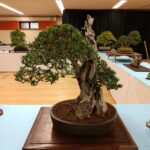 Bonsai 盆栽 & Suiseki 水石 - Miniature Japanese trees, natural stone artwork and appreciation The art form of bonsai captures the grandeur and beauty of nature on a reduced scale, producing miniature trees and plants. Similarly, naturally occurring and expressive stones that are categorized as suiseki are used to create landscapes like mountains and waterfalls. The Bonsai and Suiseki Exhibit has…
Bonsai 盆栽 & Suiseki 水石 - Miniature Japanese trees, natural stone artwork and appreciation The art form of bonsai captures the grandeur and beauty of nature on a reduced scale, producing miniature trees and plants. Similarly, naturally occurring and expressive stones that are categorized as suiseki are used to create landscapes like mountains and waterfalls. The Bonsai and Suiseki Exhibit has… 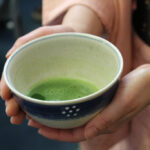 Chanoyu 茶の湯 - Way of Tea CHA-NO-YU (literally, hot water for tea), or SA-DÔ (also CHA-DÔ, the Way of Tea), is one of the most highly refined traditional arts of Japan. It has been an important influence on Japanese architecture, landscape gardening, ceramics, and floral arts. Chanoyu has also shaped many of the artistic values and social etiquette…
Chanoyu 茶の湯 - Way of Tea CHA-NO-YU (literally, hot water for tea), or SA-DÔ (also CHA-DÔ, the Way of Tea), is one of the most highly refined traditional arts of Japan. It has been an important influence on Japanese architecture, landscape gardening, ceramics, and floral arts. Chanoyu has also shaped many of the artistic values and social etiquette… 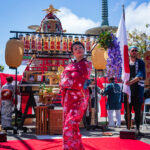 Dance 踊り - Experience contemporary and traditional styles of odori (Japanese dance) on the Japantown Peace Plaza Stage, the Japanese Cultural and Community Center of Northern California (JCCCNC/the Center) Stage, and the Grand Parade! The variety of odori is specific to different Japanese regions and festivals, like Awa Odori and Bon Odori. Some dance groups are performing ensemble…
Dance 踊り - Experience contemporary and traditional styles of odori (Japanese dance) on the Japantown Peace Plaza Stage, the Japanese Cultural and Community Center of Northern California (JCCCNC/the Center) Stage, and the Grand Parade! The variety of odori is specific to different Japanese regions and festivals, like Awa Odori and Bon Odori. Some dance groups are performing ensemble… 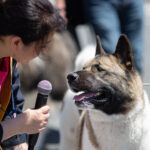 Dogs 犬 - The Festival is honored to invite Akita and Shiba to participate in informational meet and greet booths and to stroll with their owners in the Grand Parade. The Akita and Shiba club members bring their beloved dogs to meet each other and to receive a lot of attention and petting! We hope that you enjoy…
Dogs 犬 - The Festival is honored to invite Akita and Shiba to participate in informational meet and greet booths and to stroll with their owners in the Grand Parade. The Akita and Shiba club members bring their beloved dogs to meet each other and to receive a lot of attention and petting! We hope that you enjoy… 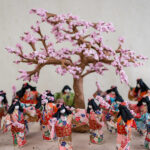 Doll Making 人形 - Washi Ningyo, Mataro Dolls Washi Ningyo 和紙人形 (3D Japanese Paper Dolls) Favored by girls in Japan since the early 1500’s, Washi Ningyo (3D Japanese paper dolls) originated from a paper doll called Anesama Ningyo (flat dolls). You can learn Japanese culture and history as you make the doll by hand, using special Japanese Washi paper…
Doll Making 人形 - Washi Ningyo, Mataro Dolls Washi Ningyo 和紙人形 (3D Japanese Paper Dolls) Favored by girls in Japan since the early 1500’s, Washi Ningyo (3D Japanese paper dolls) originated from a paper doll called Anesama Ningyo (flat dolls). You can learn Japanese culture and history as you make the doll by hand, using special Japanese Washi paper… 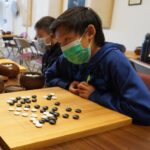 Go 囲碁 - Go, also known as “Igo” in Japan, is a traditional board game with a rich history and cultural significance in Japan and around the world. In Japan, the game has been played for over a thousand years and is considered one of the country’s traditional arts. In San Francisco, Go has been actively played in…
Go 囲碁 - Go, also known as “Igo” in Japan, is a traditional board game with a rich history and cultural significance in Japan and around the world. In Japan, the game has been played for over a thousand years and is considered one of the country’s traditional arts. In San Francisco, Go has been actively played in… 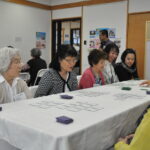 Hyakunin Isshu 百人一首 - Karuta (Japanese poetry card game) Join the San Francisco Karuta Kai and Satsuki-kai Hyakunin Isshu Club to play, Hyakunin Isshu, or “One Hundred Poems by One Hundred Poets.” One hundred poems were selected by Fujiwara-no-Teika in the 13th century and incorporated into a card game in the 16th century. The game consists of a reader reciting…
Hyakunin Isshu 百人一首 - Karuta (Japanese poetry card game) Join the San Francisco Karuta Kai and Satsuki-kai Hyakunin Isshu Club to play, Hyakunin Isshu, or “One Hundred Poems by One Hundred Poets.” One hundred poems were selected by Fujiwara-no-Teika in the 13th century and incorporated into a card game in the 16th century. The game consists of a reader reciting… 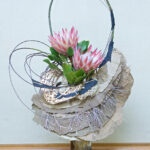 Ikebana 生花 - Flower Arrangement Ikebana is one of the most famed Japanese traditional arts, and traces its origin back hundreds of years. Ikebana was historically placed within the tokonoma alcove of the Japanese home. This art of flower arrangement is now practiced in most of the contemporary world as a seasonal design element placed throughout the home.…
Ikebana 生花 - Flower Arrangement Ikebana is one of the most famed Japanese traditional arts, and traces its origin back hundreds of years. Ikebana was historically placed within the tokonoma alcove of the Japanese home. This art of flower arrangement is now practiced in most of the contemporary world as a seasonal design element placed throughout the home.… 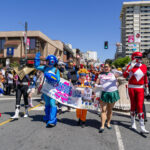 Japanese Pop Culture ジェイポップ - Since the late 20th century, Japanese pop culture has become a modern global phenomenon of influencing media, music, fashion, and lifestyle. Cultural highlights include Japanese cinema icons like Godzilla and Pikachu, good variety of Japanese television shows and dramas, anime and manga from the classic Sailor Moon to the newest Demon Slayer, eclectic J-Pop music…
Japanese Pop Culture ジェイポップ - Since the late 20th century, Japanese pop culture has become a modern global phenomenon of influencing media, music, fashion, and lifestyle. Cultural highlights include Japanese cinema icons like Godzilla and Pikachu, good variety of Japanese television shows and dramas, anime and manga from the classic Sailor Moon to the newest Demon Slayer, eclectic J-Pop music… 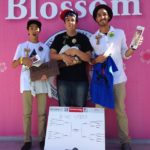 Kendama けん玉 - Kendama is a traditional Japanese toy, referred as the Japanese version of a cup-and-ball game. The kendama is made up of the ken (handle), three concave cups, the kensaki (spike), and the tama (ball) connected by the ito (string). Made of wood, the ends of the base and the crosspiece of the hammer are cupped…
Kendama けん玉 - Kendama is a traditional Japanese toy, referred as the Japanese version of a cup-and-ball game. The kendama is made up of the ken (handle), three concave cups, the kensaki (spike), and the tama (ball) connected by the ito (string). Made of wood, the ends of the base and the crosspiece of the hammer are cupped…  Martial Arts 武道 - Learn about the ways of the mind, body and spirit through many unique forms of Japanese martial arts including judo, karate, kendo, naginata, and shorinji kempo. At a future in-person Festival, enjoy an exciting variety of demonstrations on the Japantown Peace Plaza stage, showcasing the physicality and strength of our San Francisco Bay Area practitioners.…
Martial Arts 武道 - Learn about the ways of the mind, body and spirit through many unique forms of Japanese martial arts including judo, karate, kendo, naginata, and shorinji kempo. At a future in-person Festival, enjoy an exciting variety of demonstrations on the Japantown Peace Plaza stage, showcasing the physicality and strength of our San Francisco Bay Area practitioners.… 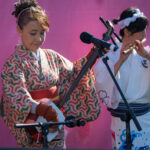 Music 音楽 - The Festival features many facets of traditional and contemporary Japanese music culture. Our performing artists sing and play live music with Japanese instruments including the harp (Koto), flute (Shakuhachi), three-stringed instrument (Shamisen/Sangen), and drum (Taiko). Experience and feel the passion of each of the talented artists as they perform for the audience at the Japantown…
Music 音楽 - The Festival features many facets of traditional and contemporary Japanese music culture. Our performing artists sing and play live music with Japanese instruments including the harp (Koto), flute (Shakuhachi), three-stringed instrument (Shamisen/Sangen), and drum (Taiko). Experience and feel the passion of each of the talented artists as they perform for the audience at the Japantown… 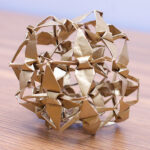 Origami 折紙 - The Art of Paperfolding Origami means “folded paper” and encompasses the art of paper folding. While simple origami figures can be produced in less than 10 steps, more complex shapes require several hundred folds and are mastered by a select few who studied origami for many years. One such expert is San Francisco native, Linda Mihara,…
Origami 折紙 - The Art of Paperfolding Origami means “folded paper” and encompasses the art of paper folding. While simple origami figures can be produced in less than 10 steps, more complex shapes require several hundred folds and are mastered by a select few who studied origami for many years. One such expert is San Francisco native, Linda Mihara,… 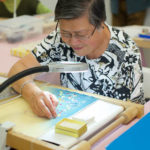 Shishu 刺繍 - Japanese Traditional Embroidery Silk and metal thread embroidery was introduced to Japan from China through Korea, and over 1,000 years has developed into traditional Japanese embroidery by the designs and materials used. The late Shishu master, Iwao Saito founded Kurenai-Kai after World War II in Chiba Prefecture, and trained apprentices to follow his embroidery methods…
Shishu 刺繍 - Japanese Traditional Embroidery Silk and metal thread embroidery was introduced to Japan from China through Korea, and over 1,000 years has developed into traditional Japanese embroidery by the designs and materials used. The late Shishu master, Iwao Saito founded Kurenai-Kai after World War II in Chiba Prefecture, and trained apprentices to follow his embroidery methods… 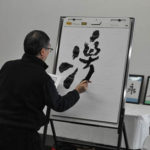 Shodo 書道 - Japanese Calligraphy Shodo or Japanese calligraphy is the fine art of using bamboo brush and ink for drawing characters by clearing the mind to create letters in fluid motion. The way in which lines are drawn—whether at the beginning or the end, and direction—is important in creating harmony and balance. Even empty space has meaning.…
Shodo 書道 - Japanese Calligraphy Shodo or Japanese calligraphy is the fine art of using bamboo brush and ink for drawing characters by clearing the mind to create letters in fluid motion. The way in which lines are drawn—whether at the beginning or the end, and direction—is important in creating harmony and balance. Even empty space has meaning.… 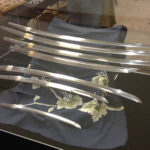 Swords 日本刀 - Appreciation of Japanese swords and armor Northern California Japanese Sword Club Based in San Francisco’s Japantown, the Northern California Japanese Sword Club is the oldest club in the United States dedicated to the study and appreciation of Japanese swords and armor, with their related history and art. We typically meet on the third Sunday of…
Swords 日本刀 - Appreciation of Japanese swords and armor Northern California Japanese Sword Club Based in San Francisco’s Japantown, the Northern California Japanese Sword Club is the oldest club in the United States dedicated to the study and appreciation of Japanese swords and armor, with their related history and art. We typically meet on the third Sunday of… 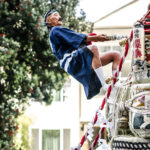 Taru Mikoshi 樽神輿 - Traditional Japanese portable shrine Every year in April, Soko Taru Mikoshi Ren, also known as San Francisco Taru Mikoshi Ren, carries their Mikoshi down the streets of San Francisco’s Japantown as the finale of the Northern California Cherry Blossom Festival’s Grand Parade. At a future in-person Festival, all members of the public are welcome to…
Taru Mikoshi 樽神輿 - Traditional Japanese portable shrine Every year in April, Soko Taru Mikoshi Ren, also known as San Francisco Taru Mikoshi Ren, carries their Mikoshi down the streets of San Francisco’s Japantown as the finale of the Northern California Cherry Blossom Festival’s Grand Parade. At a future in-person Festival, all members of the public are welcome to…
 Bonsai 盆栽 & Suiseki 水石 - Miniature Japanese trees, natural stone artwork and appreciation The art form of bonsai captures the grandeur and beauty of nature on a reduced scale, producing miniature trees and plants. Similarly, naturally occurring and expressive stones that are categorized as suiseki are used to create landscapes like mountains and waterfalls. The Bonsai and Suiseki Exhibit has…
Bonsai 盆栽 & Suiseki 水石 - Miniature Japanese trees, natural stone artwork and appreciation The art form of bonsai captures the grandeur and beauty of nature on a reduced scale, producing miniature trees and plants. Similarly, naturally occurring and expressive stones that are categorized as suiseki are used to create landscapes like mountains and waterfalls. The Bonsai and Suiseki Exhibit has…  Chanoyu 茶の湯 - Way of Tea CHA-NO-YU (literally, hot water for tea), or SA-DÔ (also CHA-DÔ, the Way of Tea), is one of the most highly refined traditional arts of Japan. It has been an important influence on Japanese architecture, landscape gardening, ceramics, and floral arts. Chanoyu has also shaped many of the artistic values and social etiquette…
Chanoyu 茶の湯 - Way of Tea CHA-NO-YU (literally, hot water for tea), or SA-DÔ (also CHA-DÔ, the Way of Tea), is one of the most highly refined traditional arts of Japan. It has been an important influence on Japanese architecture, landscape gardening, ceramics, and floral arts. Chanoyu has also shaped many of the artistic values and social etiquette…  Dance 踊り - Experience contemporary and traditional styles of odori (Japanese dance) on the Japantown Peace Plaza Stage, the Japanese Cultural and Community Center of Northern California (JCCCNC/the Center) Stage, and the Grand Parade! The variety of odori is specific to different Japanese regions and festivals, like Awa Odori and Bon Odori. Some dance groups are performing ensemble…
Dance 踊り - Experience contemporary and traditional styles of odori (Japanese dance) on the Japantown Peace Plaza Stage, the Japanese Cultural and Community Center of Northern California (JCCCNC/the Center) Stage, and the Grand Parade! The variety of odori is specific to different Japanese regions and festivals, like Awa Odori and Bon Odori. Some dance groups are performing ensemble…  Dogs 犬 - The Festival is honored to invite Akita and Shiba to participate in informational meet and greet booths and to stroll with their owners in the Grand Parade. The Akita and Shiba club members bring their beloved dogs to meet each other and to receive a lot of attention and petting! We hope that you enjoy…
Dogs 犬 - The Festival is honored to invite Akita and Shiba to participate in informational meet and greet booths and to stroll with their owners in the Grand Parade. The Akita and Shiba club members bring their beloved dogs to meet each other and to receive a lot of attention and petting! We hope that you enjoy…  Doll Making 人形 - Washi Ningyo, Mataro Dolls Washi Ningyo 和紙人形 (3D Japanese Paper Dolls) Favored by girls in Japan since the early 1500’s, Washi Ningyo (3D Japanese paper dolls) originated from a paper doll called Anesama Ningyo (flat dolls). You can learn Japanese culture and history as you make the doll by hand, using special Japanese Washi paper…
Doll Making 人形 - Washi Ningyo, Mataro Dolls Washi Ningyo 和紙人形 (3D Japanese Paper Dolls) Favored by girls in Japan since the early 1500’s, Washi Ningyo (3D Japanese paper dolls) originated from a paper doll called Anesama Ningyo (flat dolls). You can learn Japanese culture and history as you make the doll by hand, using special Japanese Washi paper…  Go 囲碁 - Go, also known as “Igo” in Japan, is a traditional board game with a rich history and cultural significance in Japan and around the world. In Japan, the game has been played for over a thousand years and is considered one of the country’s traditional arts. In San Francisco, Go has been actively played in…
Go 囲碁 - Go, also known as “Igo” in Japan, is a traditional board game with a rich history and cultural significance in Japan and around the world. In Japan, the game has been played for over a thousand years and is considered one of the country’s traditional arts. In San Francisco, Go has been actively played in…  Hyakunin Isshu 百人一首 - Karuta (Japanese poetry card game) Join the San Francisco Karuta Kai and Satsuki-kai Hyakunin Isshu Club to play, Hyakunin Isshu, or “One Hundred Poems by One Hundred Poets.” One hundred poems were selected by Fujiwara-no-Teika in the 13th century and incorporated into a card game in the 16th century. The game consists of a reader reciting…
Hyakunin Isshu 百人一首 - Karuta (Japanese poetry card game) Join the San Francisco Karuta Kai and Satsuki-kai Hyakunin Isshu Club to play, Hyakunin Isshu, or “One Hundred Poems by One Hundred Poets.” One hundred poems were selected by Fujiwara-no-Teika in the 13th century and incorporated into a card game in the 16th century. The game consists of a reader reciting…  Ikebana 生花 - Flower Arrangement Ikebana is one of the most famed Japanese traditional arts, and traces its origin back hundreds of years. Ikebana was historically placed within the tokonoma alcove of the Japanese home. This art of flower arrangement is now practiced in most of the contemporary world as a seasonal design element placed throughout the home.…
Ikebana 生花 - Flower Arrangement Ikebana is one of the most famed Japanese traditional arts, and traces its origin back hundreds of years. Ikebana was historically placed within the tokonoma alcove of the Japanese home. This art of flower arrangement is now practiced in most of the contemporary world as a seasonal design element placed throughout the home.…  Japanese Pop Culture ジェイポップ - Since the late 20th century, Japanese pop culture has become a modern global phenomenon of influencing media, music, fashion, and lifestyle. Cultural highlights include Japanese cinema icons like Godzilla and Pikachu, good variety of Japanese television shows and dramas, anime and manga from the classic Sailor Moon to the newest Demon Slayer, eclectic J-Pop music…
Japanese Pop Culture ジェイポップ - Since the late 20th century, Japanese pop culture has become a modern global phenomenon of influencing media, music, fashion, and lifestyle. Cultural highlights include Japanese cinema icons like Godzilla and Pikachu, good variety of Japanese television shows and dramas, anime and manga from the classic Sailor Moon to the newest Demon Slayer, eclectic J-Pop music…  Kendama けん玉 - Kendama is a traditional Japanese toy, referred as the Japanese version of a cup-and-ball game. The kendama is made up of the ken (handle), three concave cups, the kensaki (spike), and the tama (ball) connected by the ito (string). Made of wood, the ends of the base and the crosspiece of the hammer are cupped…
Kendama けん玉 - Kendama is a traditional Japanese toy, referred as the Japanese version of a cup-and-ball game. The kendama is made up of the ken (handle), three concave cups, the kensaki (spike), and the tama (ball) connected by the ito (string). Made of wood, the ends of the base and the crosspiece of the hammer are cupped…  Martial Arts 武道 - Learn about the ways of the mind, body and spirit through many unique forms of Japanese martial arts including judo, karate, kendo, naginata, and shorinji kempo. At a future in-person Festival, enjoy an exciting variety of demonstrations on the Japantown Peace Plaza stage, showcasing the physicality and strength of our San Francisco Bay Area practitioners.…
Martial Arts 武道 - Learn about the ways of the mind, body and spirit through many unique forms of Japanese martial arts including judo, karate, kendo, naginata, and shorinji kempo. At a future in-person Festival, enjoy an exciting variety of demonstrations on the Japantown Peace Plaza stage, showcasing the physicality and strength of our San Francisco Bay Area practitioners.…  Music 音楽 - The Festival features many facets of traditional and contemporary Japanese music culture. Our performing artists sing and play live music with Japanese instruments including the harp (Koto), flute (Shakuhachi), three-stringed instrument (Shamisen/Sangen), and drum (Taiko). Experience and feel the passion of each of the talented artists as they perform for the audience at the Japantown…
Music 音楽 - The Festival features many facets of traditional and contemporary Japanese music culture. Our performing artists sing and play live music with Japanese instruments including the harp (Koto), flute (Shakuhachi), three-stringed instrument (Shamisen/Sangen), and drum (Taiko). Experience and feel the passion of each of the talented artists as they perform for the audience at the Japantown…  Origami 折紙 - The Art of Paperfolding Origami means “folded paper” and encompasses the art of paper folding. While simple origami figures can be produced in less than 10 steps, more complex shapes require several hundred folds and are mastered by a select few who studied origami for many years. One such expert is San Francisco native, Linda Mihara,…
Origami 折紙 - The Art of Paperfolding Origami means “folded paper” and encompasses the art of paper folding. While simple origami figures can be produced in less than 10 steps, more complex shapes require several hundred folds and are mastered by a select few who studied origami for many years. One such expert is San Francisco native, Linda Mihara,…  Shishu 刺繍 - Japanese Traditional Embroidery Silk and metal thread embroidery was introduced to Japan from China through Korea, and over 1,000 years has developed into traditional Japanese embroidery by the designs and materials used. The late Shishu master, Iwao Saito founded Kurenai-Kai after World War II in Chiba Prefecture, and trained apprentices to follow his embroidery methods…
Shishu 刺繍 - Japanese Traditional Embroidery Silk and metal thread embroidery was introduced to Japan from China through Korea, and over 1,000 years has developed into traditional Japanese embroidery by the designs and materials used. The late Shishu master, Iwao Saito founded Kurenai-Kai after World War II in Chiba Prefecture, and trained apprentices to follow his embroidery methods…  Shodo 書道 - Japanese Calligraphy Shodo or Japanese calligraphy is the fine art of using bamboo brush and ink for drawing characters by clearing the mind to create letters in fluid motion. The way in which lines are drawn—whether at the beginning or the end, and direction—is important in creating harmony and balance. Even empty space has meaning.…
Shodo 書道 - Japanese Calligraphy Shodo or Japanese calligraphy is the fine art of using bamboo brush and ink for drawing characters by clearing the mind to create letters in fluid motion. The way in which lines are drawn—whether at the beginning or the end, and direction—is important in creating harmony and balance. Even empty space has meaning.…  Swords 日本刀 - Appreciation of Japanese swords and armor Northern California Japanese Sword Club Based in San Francisco’s Japantown, the Northern California Japanese Sword Club is the oldest club in the United States dedicated to the study and appreciation of Japanese swords and armor, with their related history and art. We typically meet on the third Sunday of…
Swords 日本刀 - Appreciation of Japanese swords and armor Northern California Japanese Sword Club Based in San Francisco’s Japantown, the Northern California Japanese Sword Club is the oldest club in the United States dedicated to the study and appreciation of Japanese swords and armor, with their related history and art. We typically meet on the third Sunday of…  Taru Mikoshi 樽神輿 - Traditional Japanese portable shrine Every year in April, Soko Taru Mikoshi Ren, also known as San Francisco Taru Mikoshi Ren, carries their Mikoshi down the streets of San Francisco’s Japantown as the finale of the Northern California Cherry Blossom Festival’s Grand Parade. At a future in-person Festival, all members of the public are welcome to…
Taru Mikoshi 樽神輿 - Traditional Japanese portable shrine Every year in April, Soko Taru Mikoshi Ren, also known as San Francisco Taru Mikoshi Ren, carries their Mikoshi down the streets of San Francisco’s Japantown as the finale of the Northern California Cherry Blossom Festival’s Grand Parade. At a future in-person Festival, all members of the public are welcome to… 